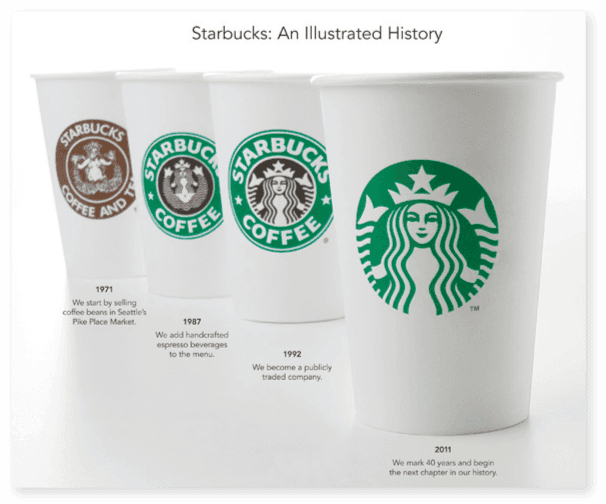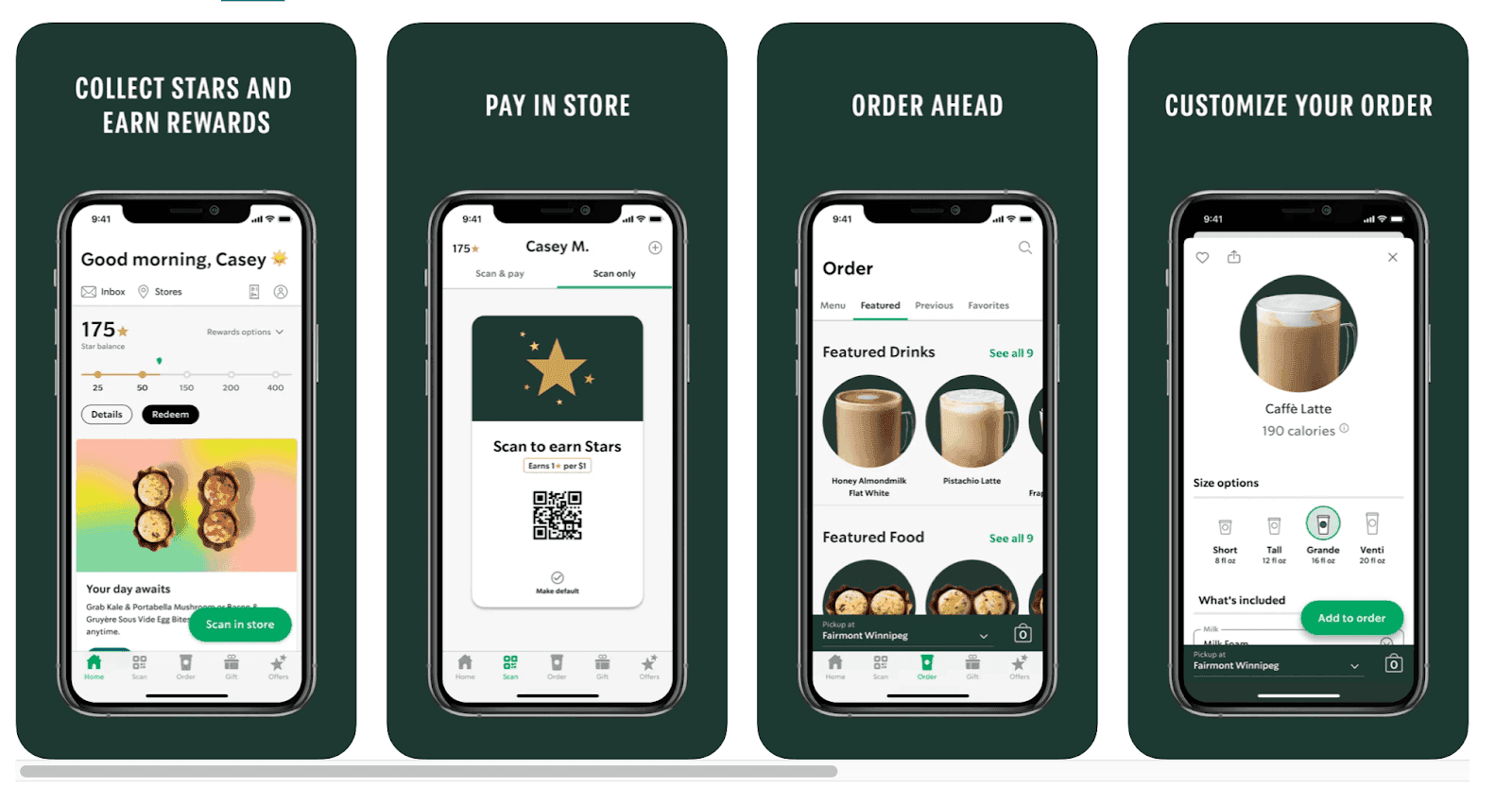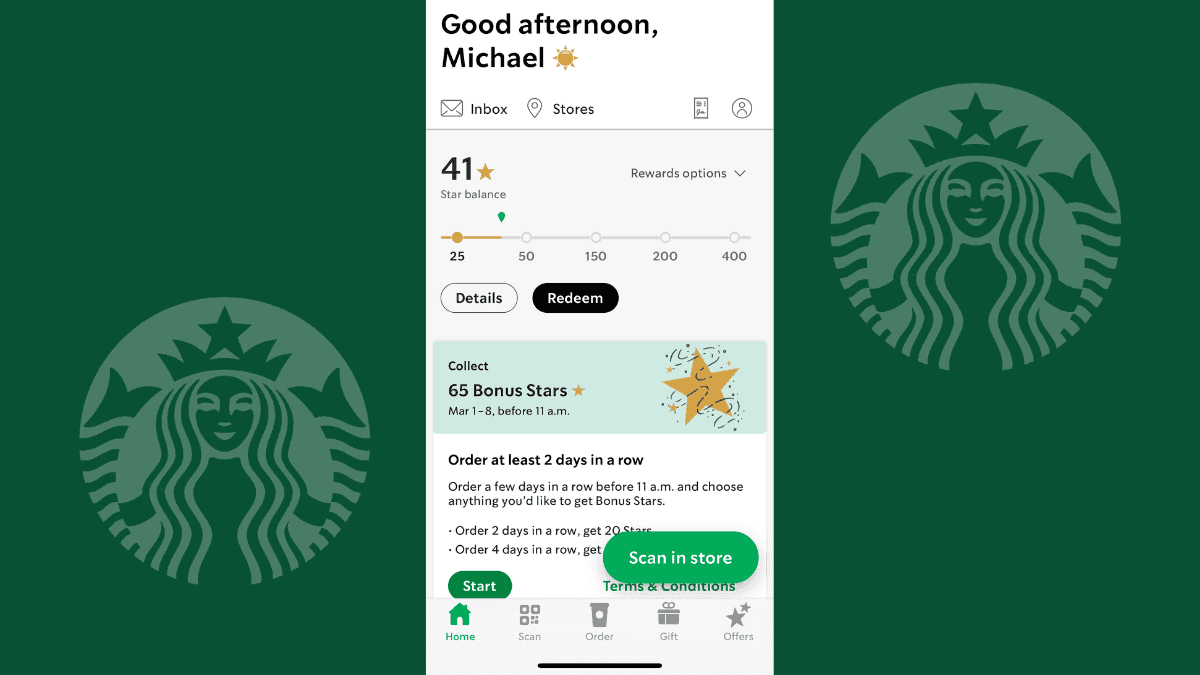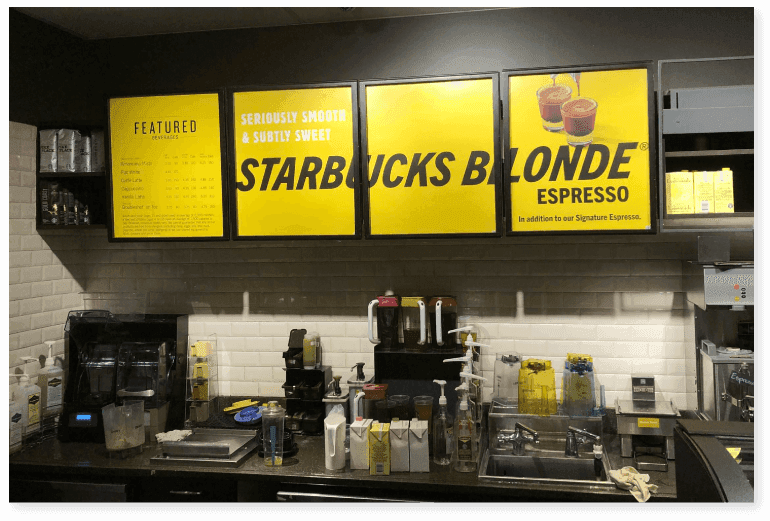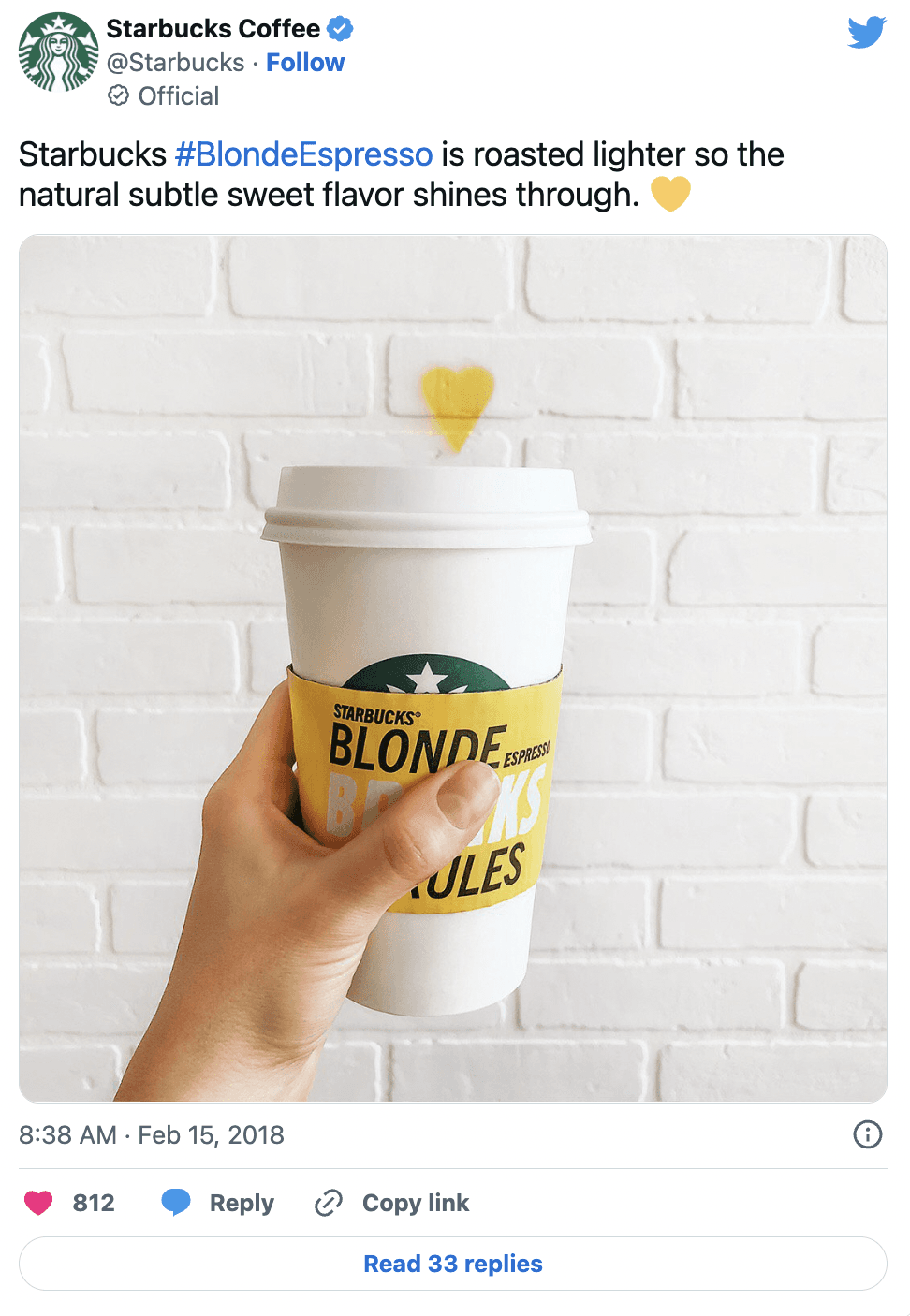Starbucks is one of the most recognizable brands in the world. Their brand recognition has reached epic heights thanks to the strength of their marketing and their commitment to keeping their brand consistent.
Not all of us have multi-million dollar marketing budgets, which makes replicating Starbucks’ marketing tactics at the same level nearly impossible.
However, there are some basic core principles behind the Starbucks marketing strategy that nearly any brand can borrow and implement.
In this post, we’ll cover how their commitment to consistent branding made Starbucks the successful brand it is today. We’ll also go over the tactics they are currently using that are continuing their tradition. Plus, we’ll cover actionable takeaways you can use to implement those marketing strategies and basic branding principles yourself.
Download Your Marketing Strategy Template Bundle
Once you’ve read how Starbucks has mastered the art of branding and marketing strategy, use these templates to get organized, document your strategy, and build brand consistency into everything you do.
In this bundle, you’ll receive:
- A marketing strategy template to format all your ideas into a workable outline for you and your team to follow.
- A marketing calendar template to organize all your projects.
- A brand style guide template to help your marketing team maintain branding consistency.
Each of these templates will help you get your marketing team organized and outline the expectations that need to be met to keep everything consistent.
The History Of Starbucks
Starbucks was founded in 1971 by Jerry Baldwin, Zev Siegl, and Gordon Bowker. At first, the coffee company only sold coffee beans and didn’t offer the premium coffee drinks it’s known for now.
The famous logo, inspired by Norse woodcutting that contained a siren, the mermaid-like figure has been with the company since its inception (although it has undergone a few redesigns).
In 1986, the original owners sold Starbucks to former manager Howard Schultz, who took the brand and helped build it into the coffee behemoth it is today.
Here is a brief overview of the growth the company has experienced in the last 47 years:

The Mission Of Starbucks
Starbucks has changed from the bean roaster of the 1970’s to the coffee inspired drink shop of today.
The original vision of Starbucks is reflected in their initial mission statement which was:
“Establish Starbucks as the premier purveyor of the finest coffee in the world while maintaining our uncompromising principles while we grow.”
After Howard Schultz bought the company from its founding members in 1987 the company has focused on creating Starbucks to be the “Third Place.” The idea of the third place is one that exists between work and home.
It was the idea of the third place that created the new mission statement for Starbucks which is:
“To inspire and nurture the human spirit – one person, one cup and one neighborhood at a time.”
Starbucks focuses on creating that personal connection between their customers, their baristas and their organization.
How Starbucks Caters To Its Target Audience
As you can see from their mission statement, Starbucks is all about connecting with their customers.
But who are their customers?
According to a research report done in April 2017, the target audience for Starbucks is men and women in the middle to upper classes who can afford Starbucks higher priced beverages regularly.
So how do they convince people to fork over that kind of cash, when they could just have coffee at home?
They offer their target audience an experience when they come into their stores.
By focusing on the third place and giving their customers a place to be and interact, they make the price of the drink worth it in the eyes of their customers.
There is something comforting about ordering a good cup of coffee and being encouraged to sit in the shop with your laptop and work. That’s the experience Starbucks provides.
The Consistency Of Starbucks’ Branding & Experience
As an internationally recognized brand, Starbucks needs to be consistent with their branding at all times. This spans every message they send, every piece of branded collateral they create, and every aspect of their in-store design and experience.
The Classic Siren Logo
Let’s start with their logo and branding design.
Over the course of 47 years, the Starbucks logo alone has gone through four different redesigns to create the iconic symbol that graces your coffee cup today.
According to Work Design Group, when Starbucks decided to revamp their branding in 2011, they faced a specific challenge.
By operating in 55 different countries, they needed a brand design that would appeal to a broad audience base. Thus the latest logo was born.
Later on, the words Starbucks and Coffee were cut from the cup so the brand could potentially expand beyond coffee products.
Unbeatable Branding Consistency
That clean, modern design philosophy extends to everything they create.
From the atmosphere in their stores, to their digital content, to their advertising, everything looks, sounds, and feels like Starbucks.
Even the cups and tumblers you can buy in the store have a clean, modern design to them.
The result? The experience you have with Starbucks always feels consistent, whether you’re reading a social post, waiting in line, watching a TV ad, or interacting with their brand in any way, anywhere.
I can walk into my local Starbucks and another one an hour away and have the same experience. I know that their sizing will still be referred in the same Italian name sizes (Tall, Grande, Venti etc.), and the coffee I order in one store will taste the same as the other.
Technology & A Shift In Brand Identity
Starbucks has been a distinguished mobile pioneer for years.
After identifying the smartphone revolution early on, the company launched its first mobile app in 2009. Then, in 2011, rolled out its beloved in-app payment feature. But by 2014, the game changed: Starbucks created mobile order ahead, prepay, and pickup.
No queue, no wait time; people adored the effortless convenience.
However, while transactions increased, the “third place,” the very notion behind Starbucks’ existence, began to slip.
In 2019 alone, to-go orders represented 80 percent of transactions, while mobile orders contributed 31 percent of total orders. Cold beverages, inherently more portable than hot, were outselling hot drinks.
Clusters of coffee drinkers in conversation were no more. The communal nature of cafés was crumbling, and with it, Starbucks’ brand identity.
Leading into 2020, company executives hinted at plans to “reinvent” or “reimagine” the “third place” concept. Starbucks was in an identity crisis, wanting to change but unsure of what new path to pursue.
Turning to its mobile app, Starbucks hoped to use digital technology to augment the feeling of connection. The key to any effective customer experience? Personalization.
The app began collecting data about individual customer preferences and purchasing behaviors to craft unique discount offers later. Additionally, when a customer picks up a mobile order, the app highlights the music playing in the store.
These seemingly small personalized touches make for a holistic brand interaction that bridges the online and physical experience.
While Starbucks continues reevaluating its brand identity, it is redefining its third space to a digital realm.
What Does Starbucks’ Marketing Mix Look Like?
Starbucks does well incorporating the four P’s throughout their marketing mix. Let’s dive in a bit to see how they’re doing it.
Product
Starbucks’ product has to be high quality to get their target audience to justify buying it. You’re paying for premium coffee which means it needs to taste better than the same iced macchiato that you could get at a McDonald’s drive-through for less.
It’s being able to craft a high-quality product every time that keeps people coming back. Not to mention their barista promise, that if you don’t like your drink, they’ll fix it.
Price
Starbucks sells their coffee at a premium price, or at least 25% higher than value brands. In 1990, only three percent of the coffee sold in the United States was sold at premium prices. By 2000, that number rose to 40% in what the Harvard Business Review calls, “The Starbucks Effect.”
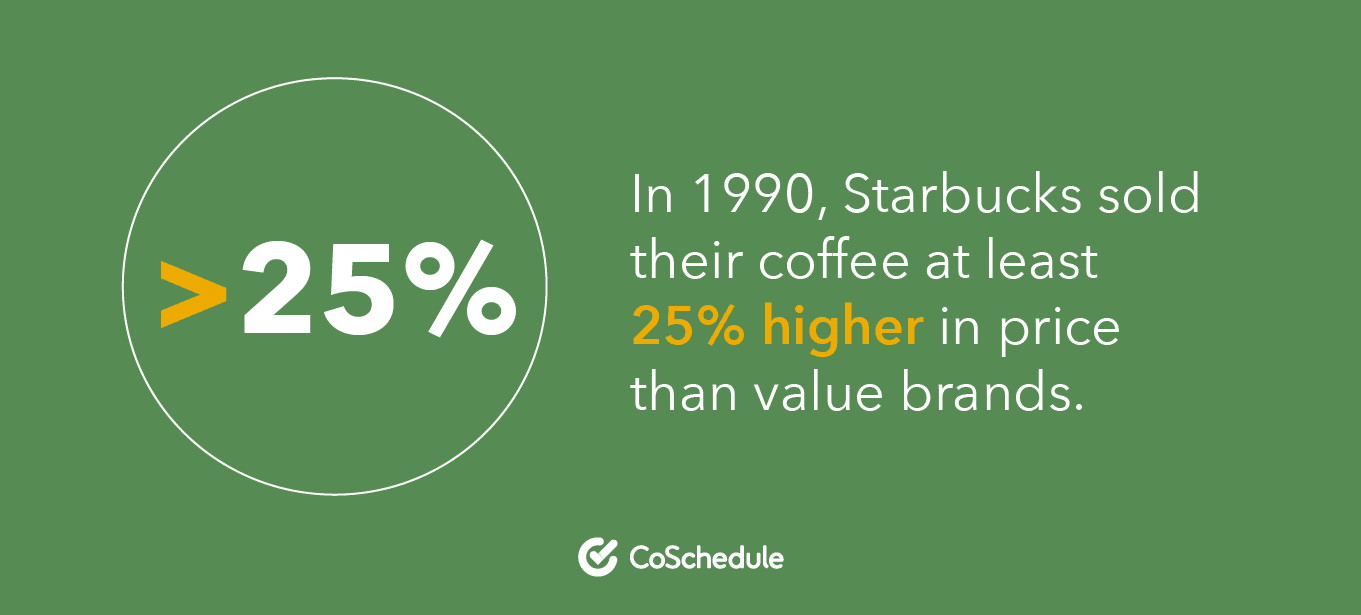
By offering customers exceptional drinks and food, Starbucks can charge more for them. Why? Because people are willing to pay for it.
Promotion
Starbucks uses a large variety of channels to market their product from social media to TV spots and ads. It’s their mix of marketing media that makes their brand recognizable, and it’s the consistent message that comes across every time that makes them stand out.
All of that promotion isn’t cheap. However, compared to other major global brands like Apple and Nike, Starbucks spends significantly less on their marketing and can still make an impact.
Place
Read anything about Starbucks, and they’ll probably mention the idea of “the third place.” Their efforts to create a space where people want to come and hang out and relax. They do this by creating a similar environment in every Starbucks location.
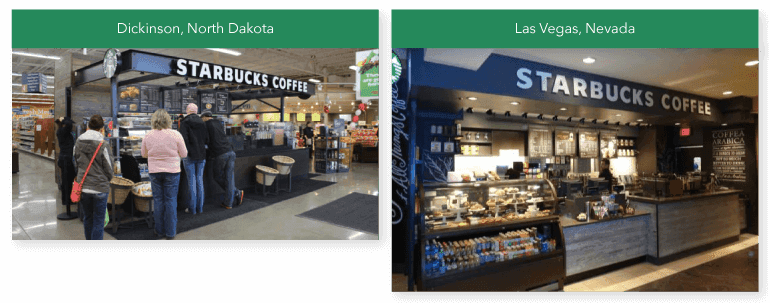
The Content Starbucks Creates Highlights Their Dedication To Consistency
So we may have mentioned this once or twice already, but consistency to their branding and their content is what puts Starbucks’ marketing strategy over the top.
Every piece of content they publish follows the same visual and language guidelines that customers have come to expect from the coffee giant. Take a look at the cohesiveness between the following examples.
Social Media
Take this Instagram post for example:
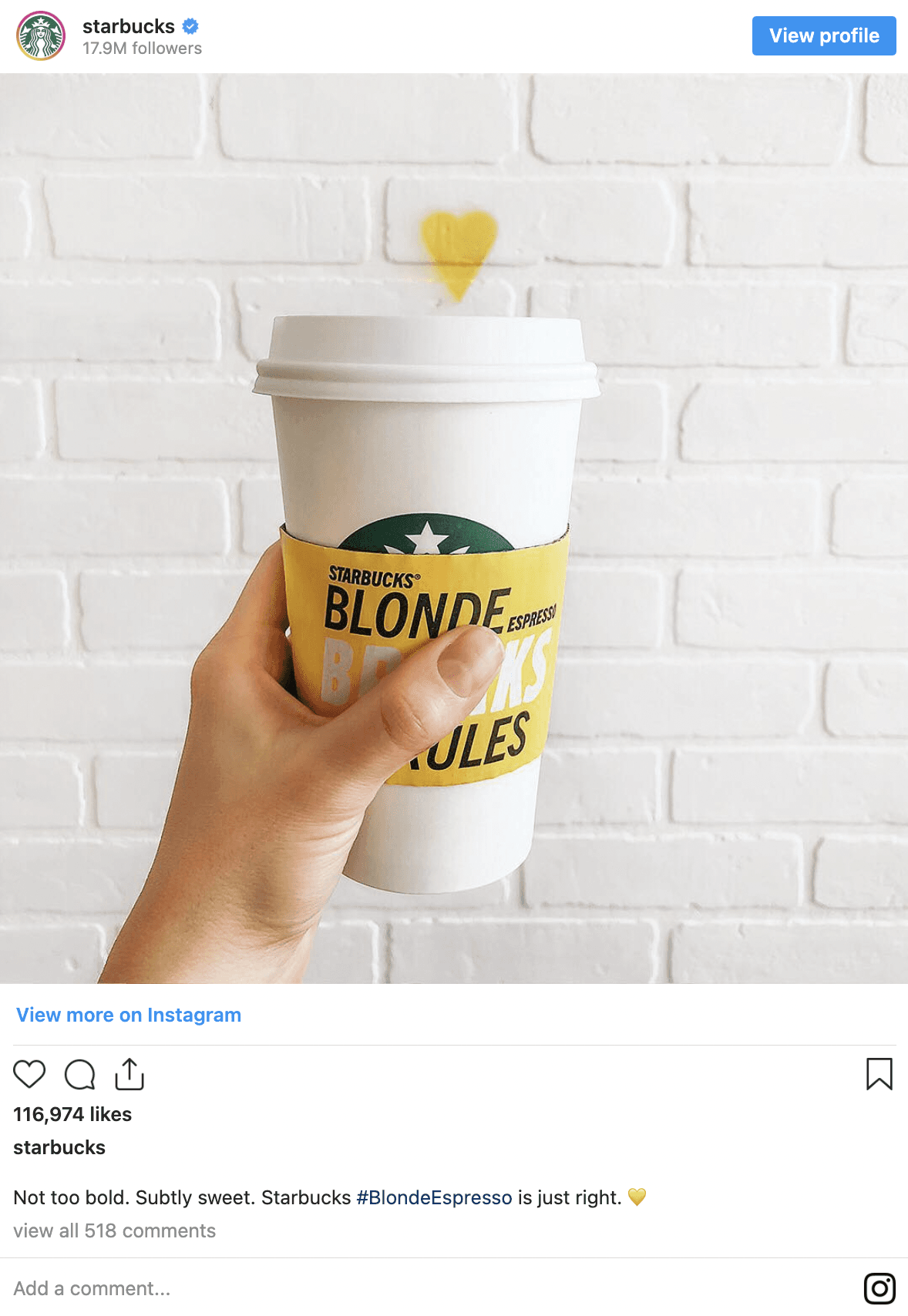
The photo is bright, modern, clean, and reflective of the Starbucks brand. The language in the post describes their new espresso shot in the same way that they would if they were chatting with a customer in the store, short, sweet, and to the point.
Web Page
Now let’s say that the Instagram post caught your attention. It intrigued you to the point where you wanted to learn more. So you grab your laptop and find the landing page for Starbucks’ brand new blonde espresso:
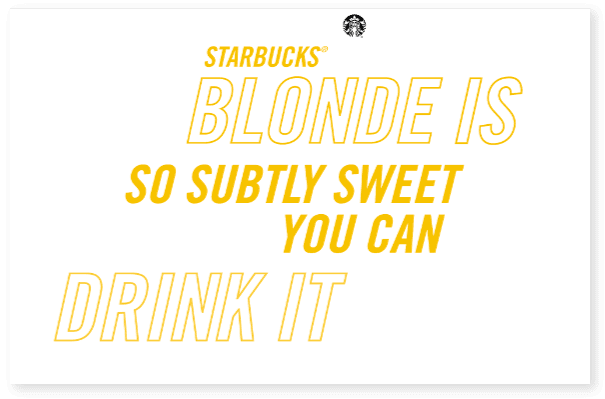
On that page you’ll see consistent copy, except this time you’ll find a little bit more about why Starbucks has brought out the blonde espresso. They also help cater to their audience and show different recipes that their customers can order to try the new shot.
Video
Finally, as you keep scrolling down the web page, you see a video:
In the video, you see a blended version of the 16-second spots that Starbucks created to launch the new blonde espresso. Once again, imagery, colors, and even language match the same style and tone as the Instagram post that we started with.
When you enter the store, you’ll also see it branded to promote their new coffee:
So what does all of this show to a fellow marketer?
Consistent messaging, imagery, and branding is key to delivering a lasting message to your customers.
Every piece of content that was part of this campaign was flawlessly designed and matched perfectly. From first touch to final purchase, the experience is consistent.
That level of consistency should be part of every piece your brand creates.
7 Ways Starbucks Executes Its Remarkable Marketing Strategy (That You Can Copy)
So now you know a bit more about what makes Starbucks’ marketing strategy successful. So how can you as a manager incorporate some of those strategies into your work?
Create A Loyalty Program
Starbucks has a great way of rewarding their customers who purchase their products. The Starbucks Rewards program offers incentives for buying products with free in-store refills, free products (after a certain amount of money is spent), and extra offers and discounts in the store.
Not to mention, the mobile app makes it easy for customers to pay ahead and find a store location.
Whether it’s a mobile app program or something as simple as a punch card, try using a loyalty program to incentivize your customers to come back to your organization.
Repurpose Content Across Each Of Your Social Media Channels
Social media can be a powerhouse for any marketing team if used correctly, and Starbucks is doing just that through:
- Repurposing content
- Interacting with their customers
Starbucks creates a lot of content. However, they make it easier by repurposing content across their social media channels.
By repurposing, I mean breaking down a larger piece of content into smaller sections to reuse across multiple channels.
Now, Starbucks doesn’t copy posts word for word and paste them across every network. Each social media channel is different and requires its message.
Take a look at the following photo that was used across three of their social media channels.
Facebook:
Twitter:
Instagram:
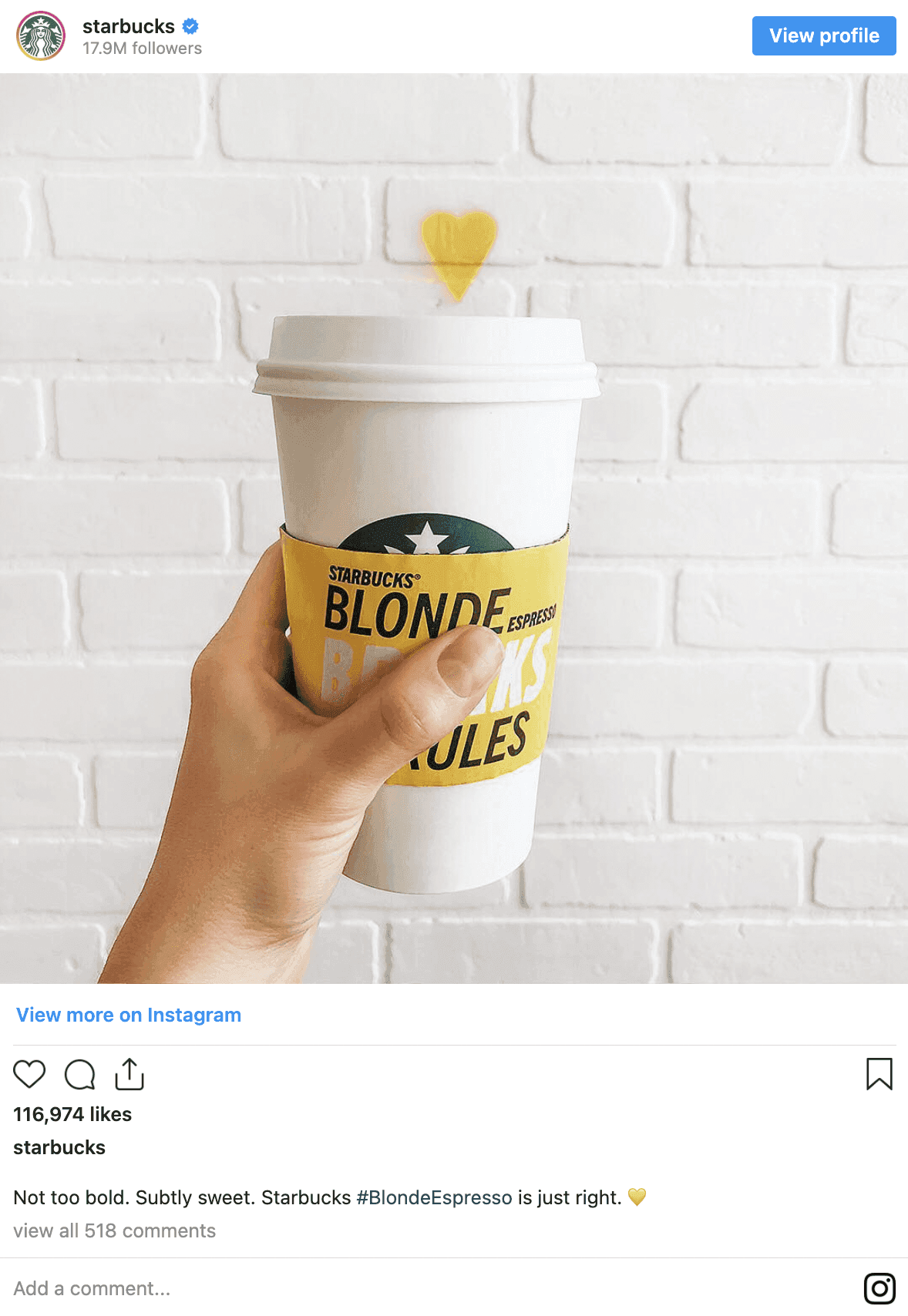
Each one of the posts is slightly different but still contains similar language that delivers the same message across to their audience.
So how can you do this for yourself?
Step One: Choose the language you want to use in each of your messages.
This could be as simple as product descriptors or a key phrase that needs to be in every part of your post.
Take the Starbucks posts for example. Each one contains the same “sublty sweet” reference.
Step Two: Tailor your message for each social media channel.
Each social media channel has its own set of message parameters and best practices that writers should follow.
For example, you have a 280 character limit on Twitter or hashtags aren’t encouraged for Facebook posts.
Step Three: Post at the best time.
Your social media message is only as effective as the number of people who see it. So posting at the best time for each channel can help you maximize the views your content gets.
Offer Friendly Customer Service On Social Media
They also use their social media channels (primarily Twitter) to create conversations with their fans and customers, much like the ones their baristas would have in store. These are usually short and sweet conversations that touch on the customer’s experience with the brand.
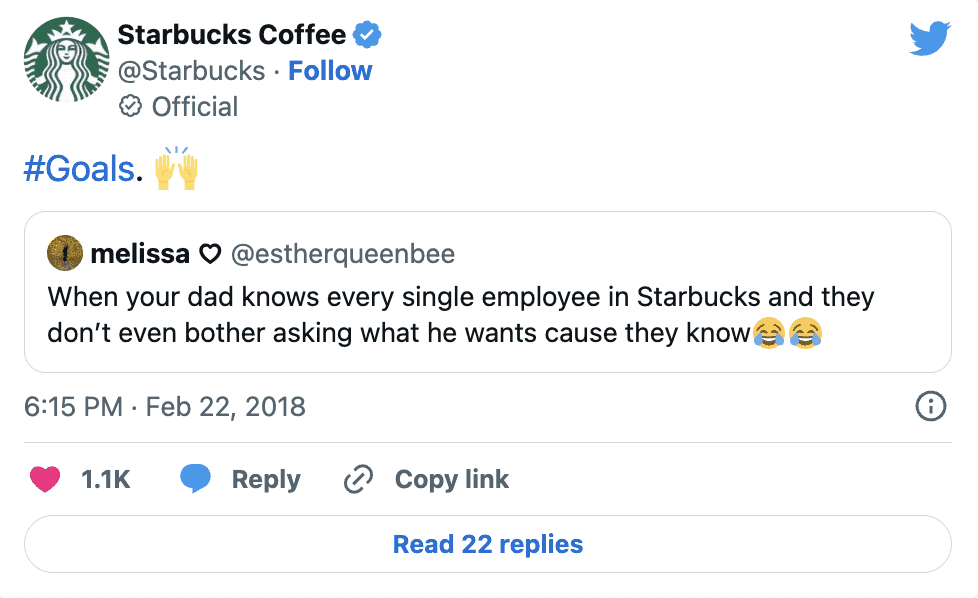
By making the most of the content they create and making their social media channels a place of conversation between their customers and the brand, Starbucks can solidify that relationship.
You can do this too.
Step 1: Choose a channel to focus on for customer support.
Choose a channel or channels that you’ll spend a majority of your time interacting with fans on. This could be the channel they are most active on or one that is more conducive to conversation.
Go through your social media analytics and look at engagement rates for each channel. Your engagement rate is calculated with this equation:
Engagement rate= total interactions of posts in a time period / number of followers on that page x100.
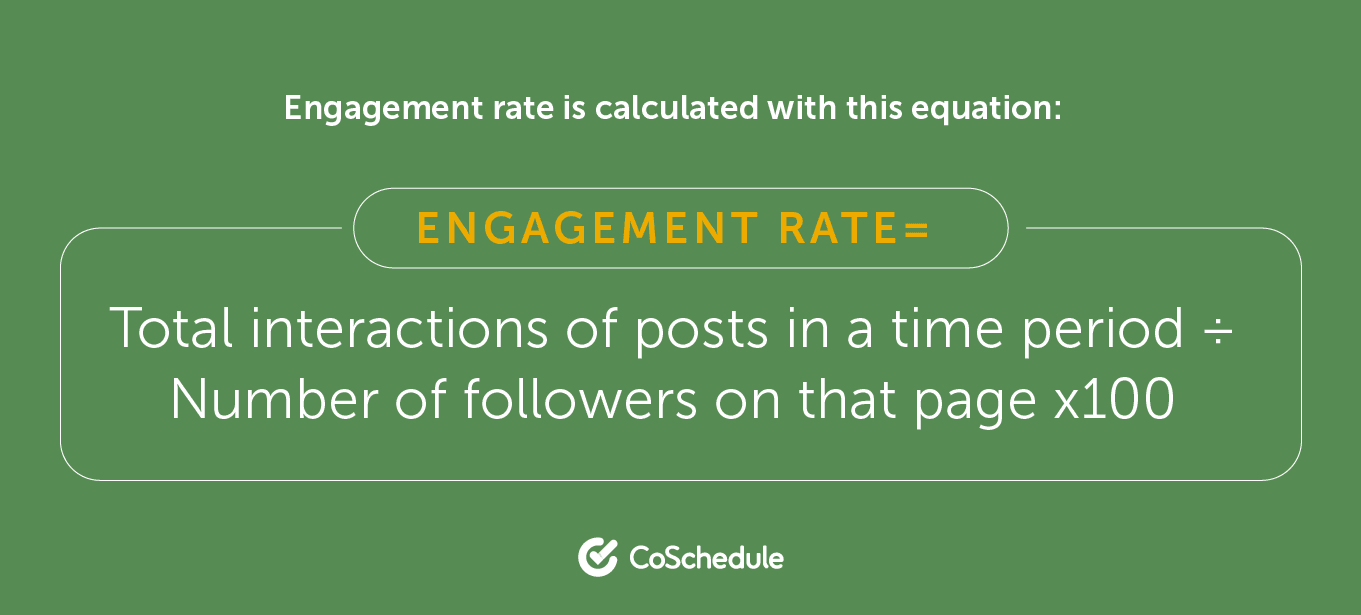
Step 2: Create messaging guidelines for your social team.
The next step is to create a series of guidelines or templates that help the person respond in the same voice and tone as your brand.
Those guidelines could look something like this.
- Don’t use emojis when responding on Facebook.
- Refer to our locations as lounges or stores.
- Always be friendly and polite.
- Use abbreviations only when necessary.
Step 3: Automate social media to maintain a consistent stream of content.
The last step in your process will be to automate your social media to keep a steady stream of content on each channel for your followers and fans to interact with.
If you’re a CoSchedule customer, ReQueue makes it easy to automate and republish your best social media content. This feature that’s built directly into your CoSchedule calendar will intelligently fill gaps in your schedule with your best evergreen content.
This video walks you through just how easy it is to start republishing your best content:
Use FOMO To Your Advantage With Limited-Time Products
There’s another part of the Starbucks marketing strategy that is so important for brands to understand and that you can recreate with your products. It’s creating a fear of missing out (FOMO) with your products.
Take their red holiday cups, for example. This has been a staple of their seasonal marketing since 1997. The kicker? No holiday cup is ever the same, and it’s only available for a limited time.
There’s one more example you’re probably familiar with, too.
Three words: Pumpkin Spice Latte.
Yup, Starbucks started that craze, too. When you pioneer a craze fans crave during a specific season, you know you’ve created something significant. The fact that it’s only available during the fall only increases the sales of the drink.
So how can you create that same kind of FOMO with your products?

Step One: Choose a product that your organization could offer for a limited time.
This could revolve around a season, a limited time ingredient, you name it. Once you have your product chosen, limit the time that you’re going to make the product available.
Give your customers enough time to enjoy the product, but make it short enough that their time to purchase is limited. The way Starbucks uses the seasons is a perfect example of this.
Step Two: Spread the news about the product and get your audience talking about it.
Whether that’s through social media, a press release, an email or an in-app message, get the word out to your customers as soon as possible.
Ensure that every message you send has consistent language and tone so it sends the proper message.
Maintain Consistent Branding Across Everything You Create
As a marketer, how can you bring this into your strategy? By creating brand guidelines and making sure that every aspect of your marketing sticks to them.
Stick To Your Mission Statement
Your mission statement is the promise that your company wants to fulfill for your customers. For Starbucks this is delivering individual experiences in their shops, creating great coffee, and having a positive impact on the neighborhoods they are in.
Your mission statement might be a little different.
Step One: Answer The Question “why do we exist?”
Your mission statement should answer the question: Why do we exist?
Step Two: Use this template to help get your mission statement started and work with your marketing team and upper management to figure out what your organization’s purpose is:
At [Insert organization name] our goal is to bring [objective one], [objective two], and [objective three] to our customers through [action], [action], and [action].
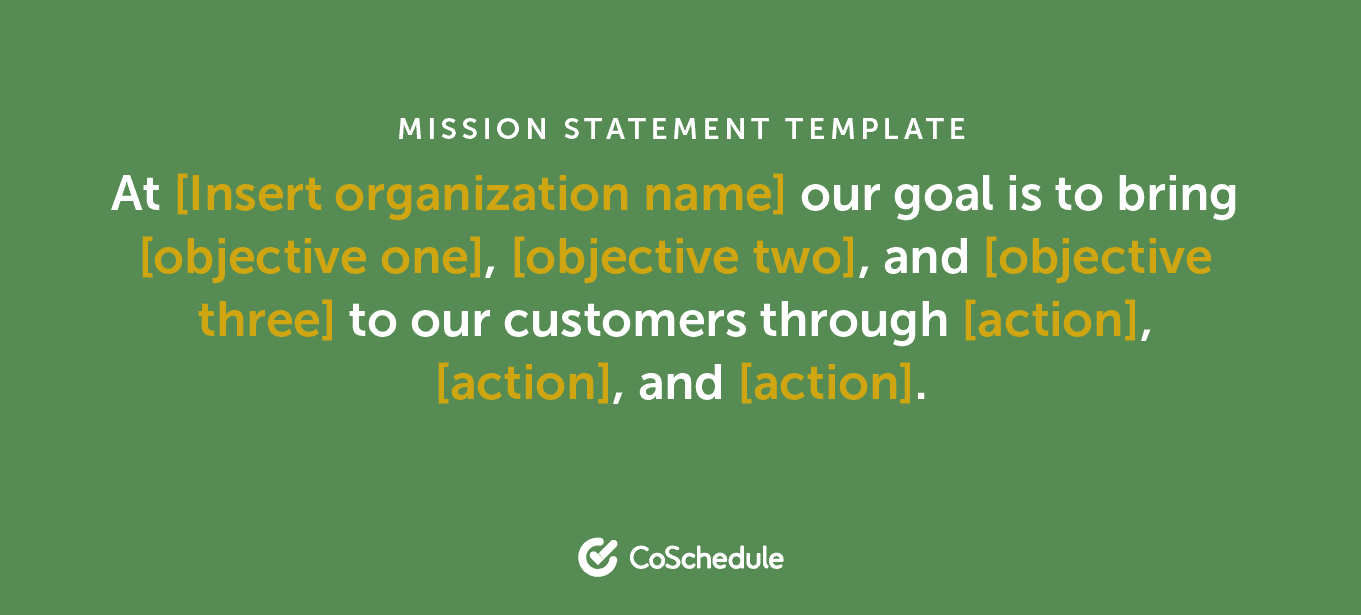
Keep Everything Organized
The last thing that you should take away from the Starbucks marketing strategy is that you need to keep everything you do organized. The scale at which Starbucks executes their strategy cannot be done by a disorganized team.
Your marketing team needs a place where one version of truth exists.
So how do you do that?
With your CoSchedule marketing calendar. It’s the one version of truth for your team.
You’ll be so organized, you’ll wonder why you didn’t switch earlier. Every piece of your marketing strategy can be planned, published, and promoted, all in one place.
Incorporate What You’ve Learned Into Your Marketing Strategy
Now you know how Starbucks stays on top of the coffee industry and why so many admire their marketing strategy.
Starbucks’ attention to detail and dedication to consistency are the reasons behind why the brand is so successful in its marketing efforts (among other reasons).
So are you inspired to jumpstart your own marketing strategy?
Recommended reading: FDA Compliance Generator


